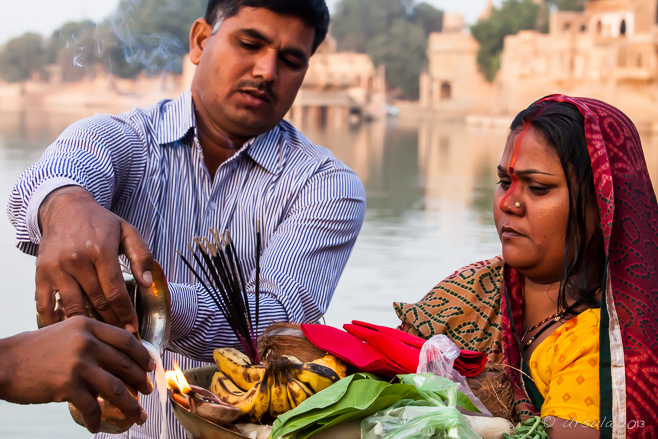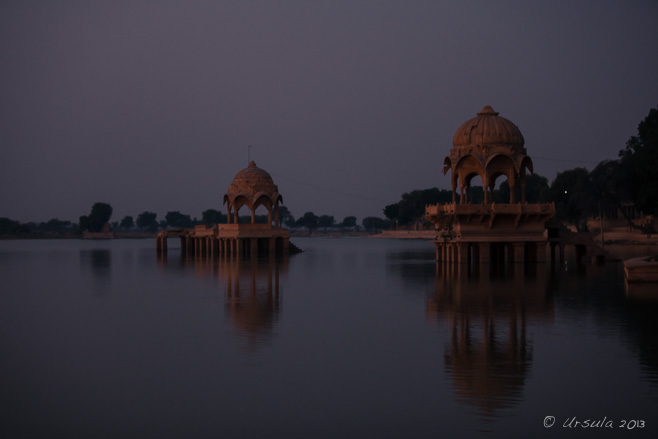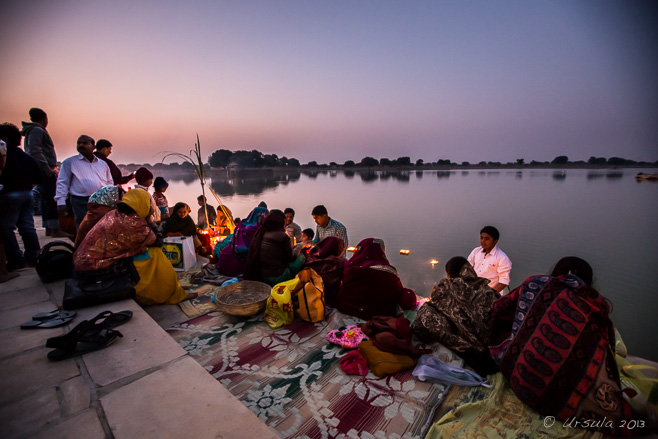
Performing the Chhath Pūjā
Standing in the cold waters of Gadsisar Lake, Jaisalmer a husband and wife present offerings to the rising sun.
It has been said that you can not count the number of deities in the Hindu cosmology. And while, technically, they are all manifestations of One Supreme Being, it does make for a lot of festivals and religious observances.
Of course, some gods – and festivals – are more important than others.
Chhath Pūjā, also known as Dala Chhath, is dedicated to the Hindu Sun God, Surya, and Chhathi Maiya, Surya’s wife or consort. Of significant importance, especially in Bihar, northern India, the four days of ritual observances are performed to thank Surya for sustaining life on earth and to ask for favours.
On the last day of the pūjā (Hindu prayer ritual), devotees gather on the banks of a river or pond to give offerings (Arghya) to the rising sun before breaking their fast with family and friends.
Kartika Shukla Shashthi, the sixth day of the month of Kartika in the Hindu Calendar, was November 9th last year. I wasn’t in Bihar – I was in the desert city of Jaisalmer with photographer Karl Grobl, local guide DV, and a small group of photo-enthusiasts – but as a significant number of people from Bihar live and work in the “Golden City” of Rajasthan, it was almost as good.

Gadsisar Lake
Before dawn, we arrived at Jaisalmer’s man-made lake, which was constructed around 1400 A.D. as a conservation tank.

On the Ghat
As early as we were, a number of Indians were already camped out at this popular pilgrimage spot.

Devotees
True worshipers follow four days of ritual bathing, fasting and abstinence. These women have been in the waters of the reservoir since 4am.

My Informant
Others participate to a lesser extent. This woman, a local English teacher, was happy to give me a place on her family’s mat, and explained the proceedings to me.

Women in their Finery
Still others welcome the opportunity to meet and chat …

Mother and Child
… and are happy to pose for pictures.

Offerings
As the morning gets lighter, offerings are made ready.

Still Standing
Parvaitin, the main worshipers, pray for the well-being of their family, and for the prosperity of their offspring.

Smiling Man

Offerings
As the sun comes up, families – with the exception of unmarried girls – come together in the water to pour milk over the offerings and say prayers. In this family, the teenaged daughter is the one taking video.

Offerings

Pavilion on Gadsisar Lake

On the Ghats
The sun is up; the worshipers share out the offerings, …

Portrait of a Teenager

Portrait of the Boys

Leaving the Pūjā
… pile into vehicles and head home for a (strictly vegetarian) feast to break the fast.

Sādhu
Chhath Pūjā is the only Hindu holy festival which involves no pandit (priest). We met met this local holy man on our way out of the lake area; he had missed out on sharing in the offerings to the sun, so I bought him a chai before heading home to my own breakfast.

I thoroughly enjoyed my breakfast after such an early start –
Though probably not as much as those Indian people who had assured their family’s good fortunes for another year.
Namaste!
Pictures: 09November2013























Wow, another fantastic post! Ursula, I love reliving the events through the images you capture…additionally, your thorough research and captivating writing style really bring it all to life again. Bravo!
Thanks, Karl! I’m glad you enjoyed it. I have a photo of you and the Sadhu I’ll send through as soon as I have Internet.